加载资源
首先Spring大部分功能主要是根据配置进行切入点,所以我们首先要分析的就是XmlBeanFactory
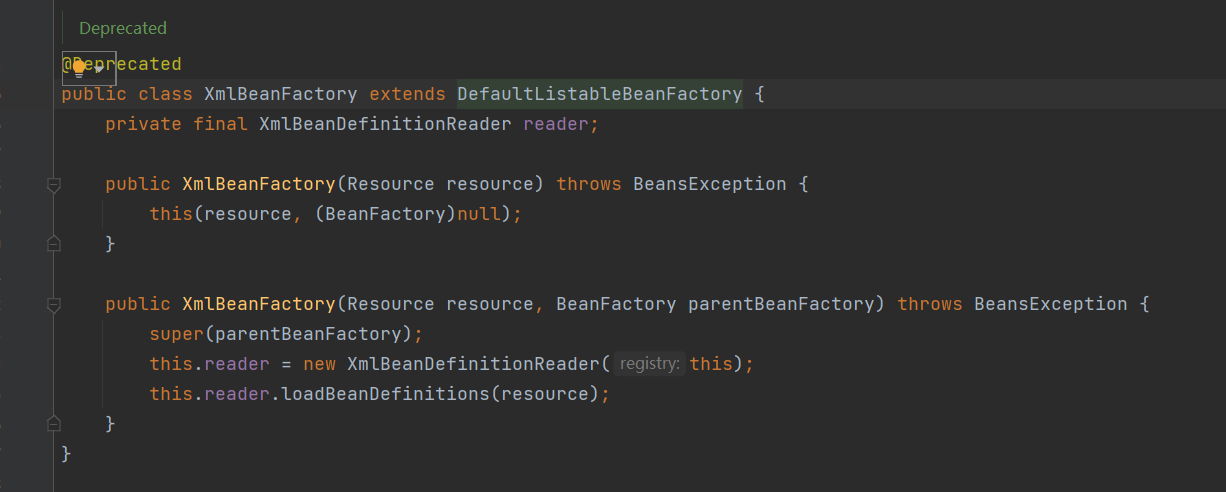
XmlBeanFactory首先调用参数为resource的构造方法:
public XmlBeanFactory(Resource resource) throws BeansException {
this(resource, (BeanFactory)null);
}构造方法的内部又调用构造方法
public XmlBeanFactory(Resource resource, BeanFactory parentBeanFactory) throws BeansException {
super(parentBeanFactory);
this.reader = new XmlBeanDefinitionReader(this);
this.reader.loadBeanDefinitions(resource);
}根据分析,加载资源主要使用的是XmlBeanDefinitionReader类进行,但是在创建创建reader之前,调用了父类的构造方法。(这个我们稍后分析)
我们首先分析参数Resource类
UML图如下:
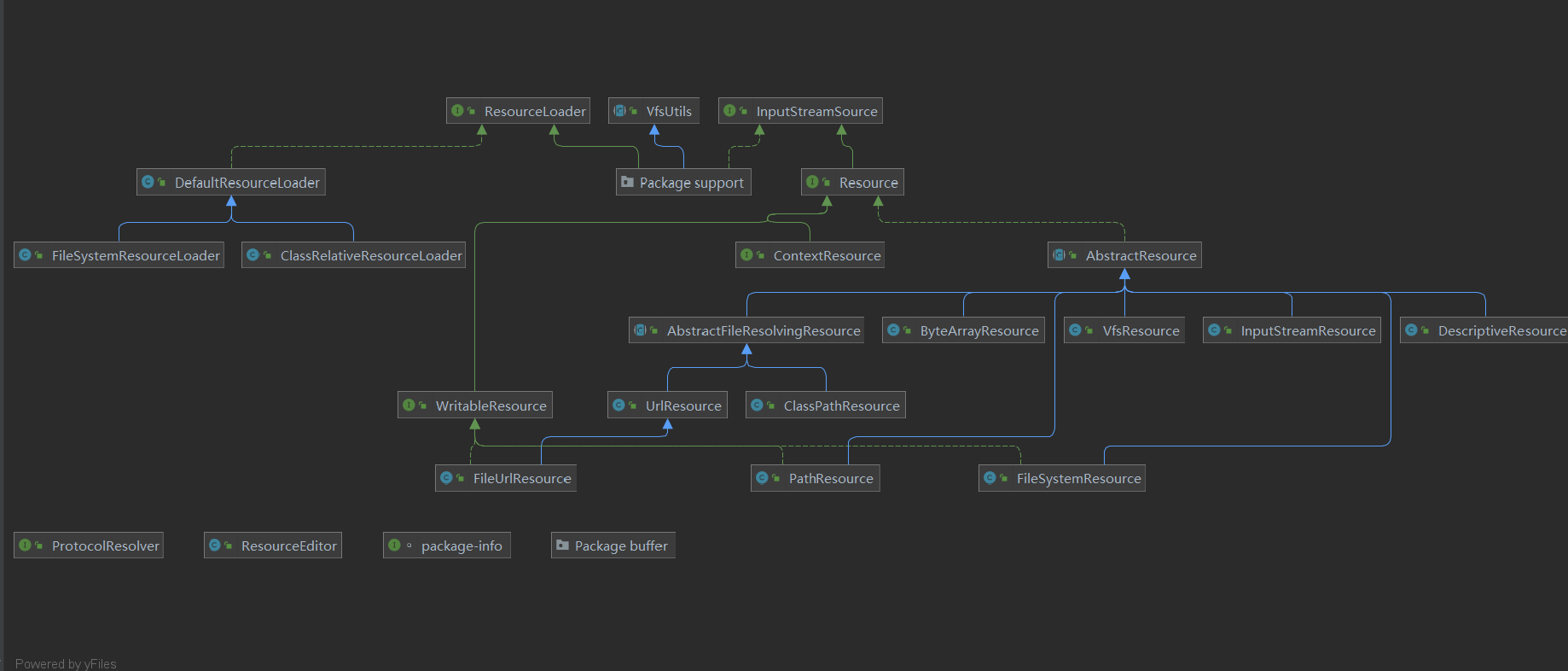
Spring配置文件读取主要通过ClassPathResource实现的,而ClassPath的父类Resource封装了底层资源,并且对于不同来源的资源文件都有一个对应Resource实现:
文件:FileSystemResource
Classpath资源:ClassPathResource
URL资源:UrlResource
InputStream:InputResource
Byte数组:ByteResource
Resourse结构:
public interface Resource extends InputStreamSource {
//是否存在
boolean exists();
//是否可读
default boolean isReadable() {
return this.exists();
}
//是否打开
default boolean isOpen() {
return false;
}
//是否是文件
default boolean isFile() {
return false;
}
//转换为URL
URL getURL() throws IOException;
//转换为URI
URI getURI() throws IOException;
//转换为文件
File getFile() throws IOException;
//NIO管道
default ReadableByteChannel readableChannel() throws IOException {
return Channels.newChannel(this.getInputStream());
}
//获取的资源长度
long contentLength() throws IOException;
//上一次修改的时间
long lastModified() throws IOException;
//基于当前资源创建相对资源
Resource createRelative(String relativePath) throws IOException;
//获取文件名
@Nullable
String getFilename();
//描述信息(打印错误信息)
String getDescription();
}Resource接口对于资源文件进行统一处理:
Resource resource = new ClassPathSource("bean.xml");
InputStream is = resource.getInputStream();ClassPathSource获取输入流逻辑如下,通过class或者classLoader提高的底层方法获取到输入流
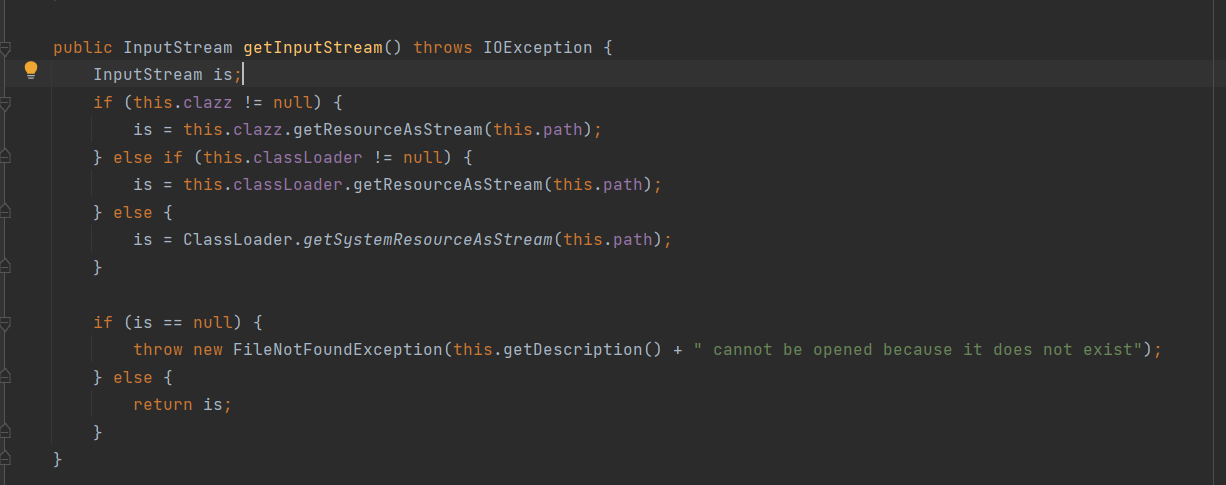
FileSystemSource获取输入流逻辑如下,简单暴力直接new了一个输入流:

有了输入流,换句话说,就是我们可以读取配置文件了,而Spring的读取配置文件全权委托给XmlBeanDefinitionReader类进行读取
ignoredDependencyInterfaces
在XmlBeanDefinitionReader.reader读取文件之前,调用了父类的构造方法:

而在父类中再次调用父类的构造方法

而在该方法中,郝佳老师提醒我们关注ignoredDependencyInterfaces方法,此方法的存在的意义就是忽略给定接口的自动装配功能


书中摘要:

总体意思不是很理解,通过网上查阅资料,大致意思就是忽略自动装配类的Set方法。使其不能自动注入
举例:
普通的pojo
@Component
public class BeanB {
}接口关键方法setBeanB
public interface BeanInterface {
public void setBeanB(BeanB beanB);
}需要自动装配的类beanA
public class BeanA implements BeanInterface {
private BeanB beanB;
public BeanB getBeanB() {
return beanB;
}
public void setBeanB(BeanB beanB) {
this.beanB = beanB;
}
}配置类:
@Configuration
public class BeanConfig {
//开启自动装配
@Bean(autowire = Autowire.BY_TYPE)
public BeanA beanA() {
return new BeanA();
}
}测试类
public static void main(String[] args) {
AnnotationConfigApplicationContext context = new AnnotationConfigApplicationContext();
context.register(SpringContextDemo.class);
context.refresh();
BeanA a = context.getBean(BeanA.class);
System.out.println(a.getBeanB());
}执行结果:
beanB存在值

添加ignoreDependencyInterface方法逻辑
public static void main(String[] args) {
AnnotationConfigApplicationContext context = new AnnotationConfigApplicationContext();
context.register(SpringContextDemo.class);
//加一行代码
context.getBeanFactory().ignoreDependencyInterface(BeanInterface.class);
context.refresh();
BeanA a = context.getBean(BeanA.class);
System.out.println(a.getBeanB());
}执行结果:

在未添加ignoreDependencyInterface方法逻辑时,Spring可以通过set方法在自动注入为BeanInterface的BeanB赋值,而beanA的自动装配需要依赖于BeanB,所以通过BeanA获取BeanB存在值
添加ignoreDependencyInterface方法逻辑时,Spring忽略了BeanInterface的set方法,所以为装配BeanB,所以通过BeanA获取BeanB为null
ignoreDependencyInterface是在Bean自动装配的BY_NAME和BY_TYPE模式下忽略该接口的set方法里面的依赖注入
读取文件
当获取到字节流时,我们就可以读取配置文件,但是Spring将读取文件的任务全权委托给XmlBeanDefinitionReader,现在学习这个类
XmlBeanDefinitionReader类有一个方法,loadBeanDefinitions:
public int loadBeanDefinitions(EncodedResource encodedResource) throws BeanDefinitionStoreException {
Assert.notNull(encodedResource, "EncodedResource must not be null");
if (this.logger.isTraceEnabled()) {
this.logger.trace("Loading XML bean definitions from " + encodedResource);
}
Set<EncodedResource> currentResources = (Set)this.resourcesCurrentlyBeingLoaded.get();
if (!currentResources.add(encodedResource)) {
throw new BeanDefinitionStoreException("Detected cyclic loading of " + encodedResource + " - check your import definitions!");
} else {
int var6;
try {
InputStream inputStream = encodedResource.getResource().getInputStream();
Throwable var4 = null;
try {
InputSource inputSource = new InputSource(inputStream);
if (encodedResource.getEncoding() != null) {
inputSource.setEncoding(encodedResource.getEncoding());
}
var6 = this.doLoadBeanDefinitions(inputSource, encodedResource.getResource());
} catch (Throwable var24) {
var4 = var24;
throw var24;
} finally {
if (inputStream != null) {
if (var4 != null) {
try {
inputStream.close();
} catch (Throwable var23) {
var4.addSuppressed(var23);
}
} else {
inputStream.close();
}
}
}
} catch (IOException var26) {
throw new BeanDefinitionStoreException("IOException parsing XML document from " + encodedResource.getResource(), var26);
} finally {
currentResources.remove(encodedResource);
if (currentResources.isEmpty()) {
this.resourcesCurrentlyBeingLoaded.remove();
}
}
return var6;
}
}首先Spring对于输入的Resouce进行了编码处理,根据传入的Resouce和编码以及字符集得到一个新的经过编码的Resouce

校验参数并打印日志

通过属性来记录已经加载的资源

通过encodeResource得到Resource并获得输出流,根据输入流生成InputSource

逻辑核心部分,开始加载

关闭流,并删除已加载的资源,避免重复加载
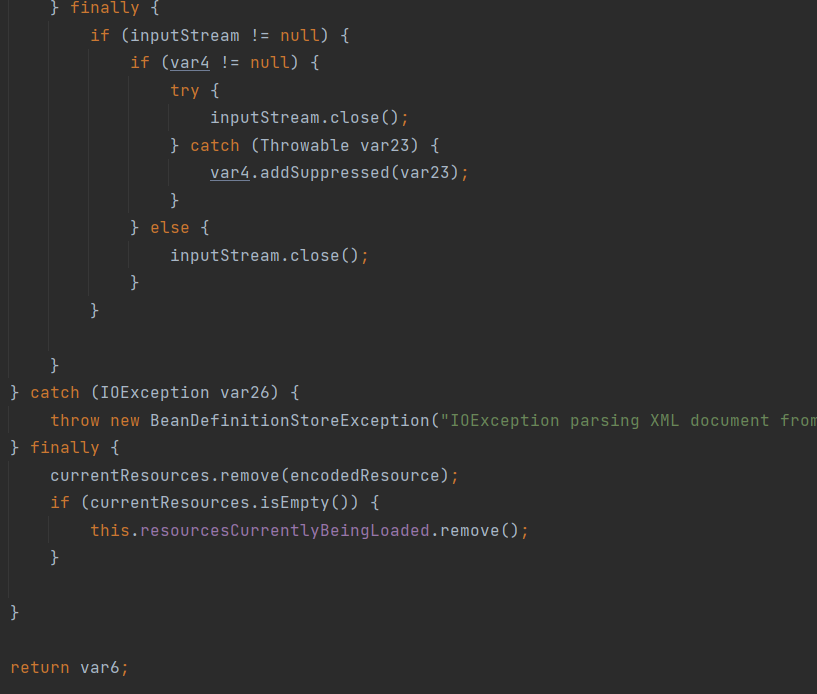
进入方法doLoadBeanDefinitions()
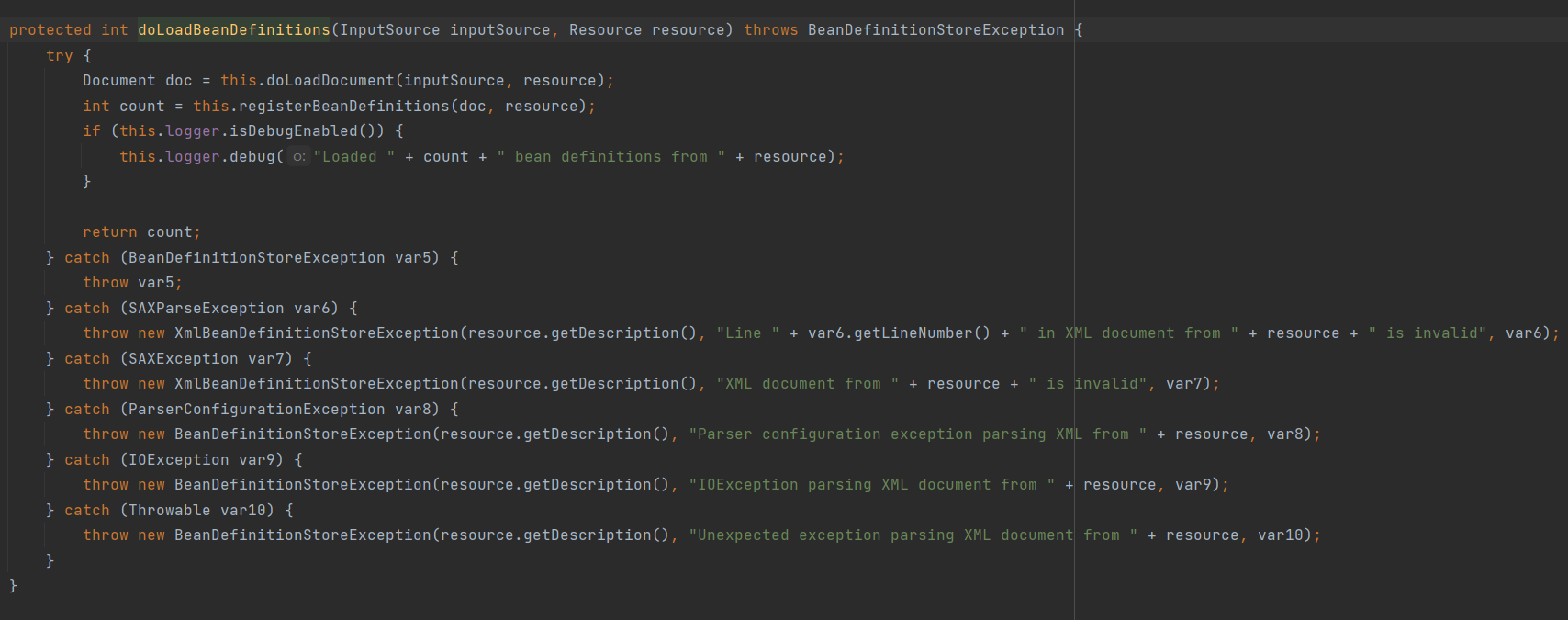
这个方法就做了两件事:
加载XML资源得到对应的Document
注册Bean信息
校验文件类型
进入方法doLoadDocument(InputSource inputSource, Resource resource)

首先进行了XML文件类型的判断即方法getValidationModeForResource(Resource resource)

0==>NONE
1==>自动加载
2==>DTD
3==>XSD
protected int getValidationModeForResource(Resource resource) {
//获取当前的XML文件的类型编码
int validationModeToUse = this.getValidationMode();
//如果不是1直接返回
if (validationModeToUse != 1) {
return validationModeToUse;
} else {
//否则执行此处
int detectedMode = this.detectValidationMode(resource);
return detectedMode != 1 ? detectedMode : 3;
}
}方法detectValidationMode(resource)
protected int detectValidationMode(Resource resource) {
//判断资源状态
if (resource.isOpen()) {
throw new BeanDefinitionStoreException("Passed-in Resource [" + resource + "] contains an open stream: cannot determine validation mode automatically. Either pass in a Resource that is able to create fresh streams, or explicitly specify the validationMode on your XmlBeanDefinitionReader instance.");
} else {
InputStream inputStream;
try {
//获取资源输入流
inputStream = resource.getInputStream();
} catch (IOException var5) {
throw new BeanDefinitionStoreException("Unable to determine validation mode for [" + resource + "]: cannot open InputStream. Did you attempt to load directly from a SAX InputSource without specifying the validationMode on your XmlBeanDefinitionReader instance?", var5);
}
try {
return this.validationModeDetector.detectValidationMode(inputStream);
} catch (IOException var4) {
throw new BeanDefinitionStoreException("Unable to determine validation mode for [" + resource + "]: an error occurred whilst reading from the InputStream.", var4);
}
}
}方法this.validationModeDetector.detectValidationMode(inputStream)
public int detectValidationMode(InputStream inputStream) throws IOException {
try {
//获取BufferedReader
BufferedReader reader = new BufferedReader(new InputStreamReader(inputStream));
Throwable var3 = null;
int var6;
try {
//是否是DTD标识
boolean isDtdValidated = false;
String content;
//一行一行读
while((content = reader.readLine()) != null) {
content = this.consumeCommentTokens(content);
//跳过注释和空行
if (!this.inComment && StringUtils.hasText(content)) {
//如果存在“DOCTYPE”属性就是DTD
if (this.hasDoctype(content)) {
isDtdValidated = true;
break;
}
//读到开始符号“<” 文件类型校验一定在开始符号前
if (this.hasOpeningTag(content)) {
break;
}
}
}
//0==>NONE
//1==>自动加载
//2==>DTD
//3==>XSD
var6 = isDtdValidated ? 2 : 3;
} catch (Throwable var16) {
var3 = var16;
throw var16;
} finally {
if (reader != null) {
if (var3 != null) {
try {
reader.close();
} catch (Throwable var15) {
var3.addSuppressed(var15);
}
} else {
reader.close();
}
}
}
return var6;
} catch (CharConversionException var18) {
return 1;
}
}加载XML文件并获取对应的Document对象
通过createDocumentBuilderFactory创建DocumentBuilderFactory,通过createDocumentBuilderFactory创建DocumentBuilder解析器对象,在根据inputSource解析返回Doucument对象

这里的逻辑不是很重要,重要的参数EntityResolver
EntityResolver
EntityResolver顾名思义就是实体分解器,实际上对于SAX而言,解析一个XML文件,SAX首先读取该文档上的声明,根据声明去寻找相应的DTD定义,一遍对文档进行一个验证。默认的寻找规则即通过网络(实际上就是声明的DTD的URI地址)来下载响应的DTD声明,并进行认证。当然,下载是一个很漫长的过程,而且当网络中断或不可用时,由于未找到想用DTD声明会报错。
而EntityResolver的作用就是项目本身就可以提供一个如何寻找DTD声明的方法,即由程序来实现寻找DTD声明的过程,比如我们将DTD文件放到项目的中的某处,在实现时直接将此文档读取并返回给SAX即可。这样就避免了通过网络来寻找响应的声明。
DTD文件:

publicId:“-//mybatis.org//DTD Mapper 3.0//EN”
systemId:"http://mybatis.org/dtd/mybatis-3-mapper.dtd"
XSD文件:

publicId:null
systemId:" http://maven.apache.org/xsd/maven-4.0.0.xsd"
而在Spring中,主要是通过DelegatingEntityResolver类中的resolveEntity()方法来解析验证

而对于DTD文件:
public InputSource resolveEntity(@Nullable String publicId, @Nullable String systemId) throws IOException {
if (logger.isTraceEnabled()) {
logger.trace("Trying to resolve XML entity with public ID [" + publicId + "] and system ID [" + systemId + "]");
}
//当systemId不为空并且是以“.dtd”结尾时才会解析
if (systemId != null && systemId.endsWith(".dtd")) {
//获取最后“/”出现的位置
int lastPathSeparator = systemId.lastIndexOf(47);
//获取“Spring-beans”在最后“/”第一次出现的位置
int dtdNameStart = systemId.indexOf("spring-beans", lastPathSeparator);
//当不存在“Spring-beans”时
if (dtdNameStart != -1) {
//手动赋值
String dtdFile = "spring-beans.dtd";
if (logger.isTraceEnabled()) {
logger.trace("Trying to locate [" + dtdFile + "] in Spring jar on classpath");
}
try {
//在当前路径下查找指定的资源
Resource resource = new ClassPathResource(dtdFile, this.getClass());
InputSource source = new InputSource(resource.getInputStream());
source.setPublicId(publicId);
source.setSystemId(systemId);
if (logger.isTraceEnabled()) {
logger.trace("Found beans DTD [" + systemId + "] in classpath: " + dtdFile);
}
return source;
} catch (FileNotFoundException var8) {
if (logger.isDebugEnabled()) {
logger.debug("Could not resolve beans DTD [" + systemId + "]: not found in classpath", var8);
}
}
}
}
return null;
}对于XSD文件:

默认是去"META-INF/spring.schemas"文件夹中获取指定的资源
解析及注册Bean
Spring注册Bean主要通过registerBeanDefinitions方法实现
registerBeanDefinitions:
public int registerBeanDefinitions(Document doc, Resource resource) throws BeanDefinitionStoreException {
//实例化BeanDefinitionDocumentReader
BeanDefinitionDocumentReader documentReader = this.createBeanDefinitionDocumentReader();
//获取容器内已经注册的bean
int countBefore = this.getRegistry().getBeanDefinitionCount();
//加载及注册bean
documentReader.registerBeanDefinitions(doc, this.createReaderContext(resource));
//此次加载及注册的bean的个数
return this.getRegistry().getBeanDefinitionCount() - countBefore;
}这里的核心功能就是
documentReader.registerBeanDefinitions(doc, this.createReaderContext(resource));
我们进入registerBeanDefinitions方法:

而这个方法的核心功能就是this.doRegisterBeanDefinitions(doc.getDocumentElement());
进入doRegisterBeanDefinitions方法
protected void doRegisterBeanDefinitions(Element root) {
BeanDefinitionParserDelegate parent = this.delegate;
//专门处理解析
this.delegate = this.createDelegate(this.getReaderContext(), root, parent);
//判断是否是默认路径(默认路径:"http://www.springframework.org/schema/beans")
if (this.delegate.isDefaultNamespace(root)) {
//处理“profile”属性
String profileSpec = root.getAttribute("profile");
if (StringUtils.hasText(profileSpec)) {
//当获取的"profile"不为空时,按照“,”";"进行切割获取到字符串数组
String[] specifiedProfiles = StringUtils.tokenizeToStringArray(profileSpec, ",; ");
if (!this.getReaderContext().getEnvironment().acceptsProfiles(specifiedProfiles)) {
if (this.logger.isDebugEnabled()) {
this.logger.debug("Skipped XML bean definition file due to specified profiles [" + profileSpec + "] not matching: " + this.getReaderContext().getResource());
}
return;
}
}
}
//解析前增强
this.preProcessXml(root);
//解析bean
this.parseBeanDefinitions(root, this.delegate);
//解析后增强
this.postProcessXml(root);
this.delegate = parent;
}
其实前置和后置方法都是无方法体的空方法,主要是便于子类实现,如果我们需要在Spring解析XML文件之前或者以后进行操作,那么我们就可以实现这个类并重写相关方法
我们进入parseBeanDefinitions
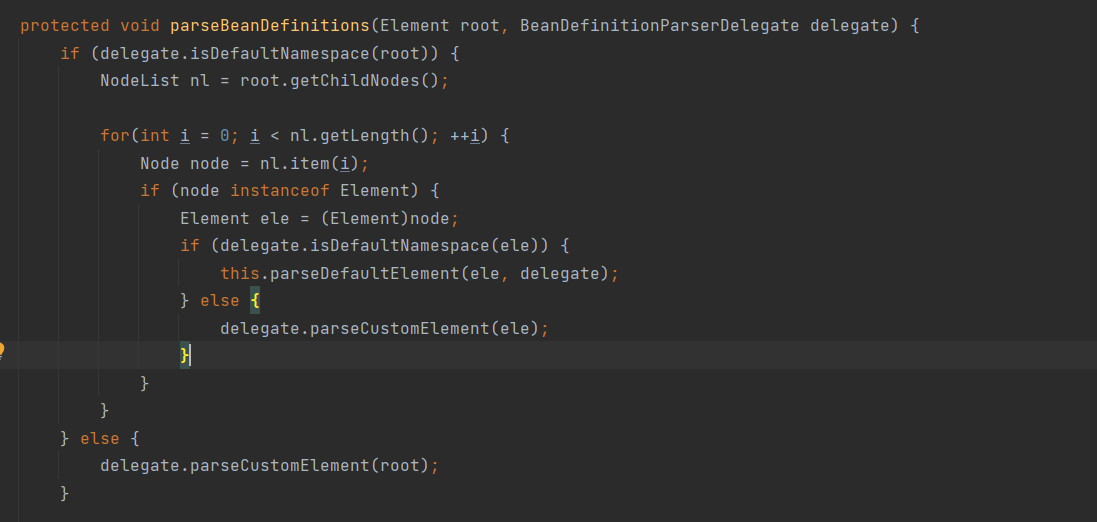
protected void parseBeanDefinitions(Element root, BeanDefinitionParserDelegate delegate) {
//判断根节点是否是默认命名空间
if (delegate.isDefaultNamespace(root)) {
//获取所有的子节点
NodeList nl = root.getChildNodes();
//遍历自己点
for(int i = 0; i < nl.getLength(); ++i) {
Node node = nl.item(i);
if (node instanceof Element) {
Element ele = (Element)node;
//判断是否是默认命名空间
if (delegate.isDefaultNamespace(ele)) {
//解析默认标签
this.parseDefaultElement(ele, delegate);
} else {
//解析自定义标签
delegate.parseCustomElement(ele);
}
}
}
} else {
//解析自定义标签
delegate.parseCustomElement(root);
}
}关于默认标签的的解析我们下个章节在学习





















 1万+
1万+

 被折叠的 条评论
为什么被折叠?
被折叠的 条评论
为什么被折叠?








